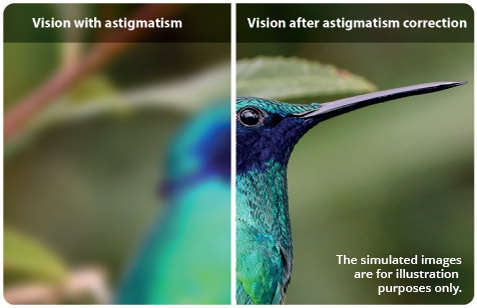What is Astigmatism?
Astigmatism is a very common eye condition that often causes blurry vision or a poor ability to focus on our surroundings – but what is it and how is it caused? Our eyes rely on the dome-shape of the cornea – the clear outer layer of the eye – to focus light into the retina, the cornea needs to have a rounded shape so that the eye can focus the image at one distance and capture a clear ‘picture’ of our surroundings.

Astigmatism happens when the shape of the cornea is slightly flatter in one dimension – so, less like a perfect dome and more like a rugby ball. This results in light being unevenly distributed, causing blurriness and distorted vision. Astigmatism can affect one or both eyes and can be developed at any age.
Types of Astigmatism
There are generally two types of astigmatism – ‘regular’ and ‘irregular’. Most astigmatism is the regular type, caused by the cornea not being spherical but steeper in one plane and flatter in the direction perpendicular to this. With irregular astigmatism, the curvatures that make up the shape of the cornea are not uniform and may have tiny, elevated lesions across the surface. This is due to the gradual thinning or distortion of the cornea and can occur after injury to the eye or as a result of a degenerating eye disease, such as keratoconus. It’s rare to find a cornea that is perfectly dome shaped, meaning many people unknowingly have a mild form of astigmatism, with little or no symptoms at all. Whilst trauma or injury can cause irregular astigmatism at any point of life, it’s thought that regular astigmatism is a genetic trait you are born with in most cases, much like the colour of our eyes or hair. However, when astigmatism has a negative impact on your vision, it’s important to get it treated, to maintain good eye health
Astigmatism Symptoms
Because the symptoms of astigmatism can be similar to other vision-affecting conditions, such as myopia (short sightedness) and hyperopia (long sightedness), regular eye check-ups are vital in properly diagnosing astigmatism. The only direct symptom of astigmatism is blurred, distorted vision at any distance, yet our eyes naturally work harder to compensate and can suffer as a result. Signs of astigmatism can include the need to squint more than usual and focus for longer periods to see objects in near or far distances. This excessive squinting can lead to eye strain and headaches that tend to occur more when you’re using your eyes in prolonged tasks, like reading or watching television. In some cases, this can result in eye irritation and discomfort, as well as feeling you need to rest your eyes more than usual.
Astigmatism Treatment
Regular astigmatism can usually be treated with corrective lenses, the same as with long or near sightedness. This could be;
-
Eyeglasses
The lens inside your eye glasses helps to bend the light symmetrically into your eye, to counteract the distorted vision astigmatism causes.
-
Contact lenses
If you play sports or have an active lifestyle and feel that glasses would ‘get in the way’, you might prefer the option of contact lenses, which can correct most cases of astigmatism in the same way.
-
Refractive surgery
Severe cases of astigmatism that cannot be fully rectified through corrective lenses may be treated with refractive surgery. This involves using lasers or small incisions to correct the shape of the cornea. This is different from refractive lens surgery, which is most commonly used to treat presbyopia.
You can discuss the best treatment option for you with your optometrist who will perform tests to determine the prescription needed to correct your astigmatism.
